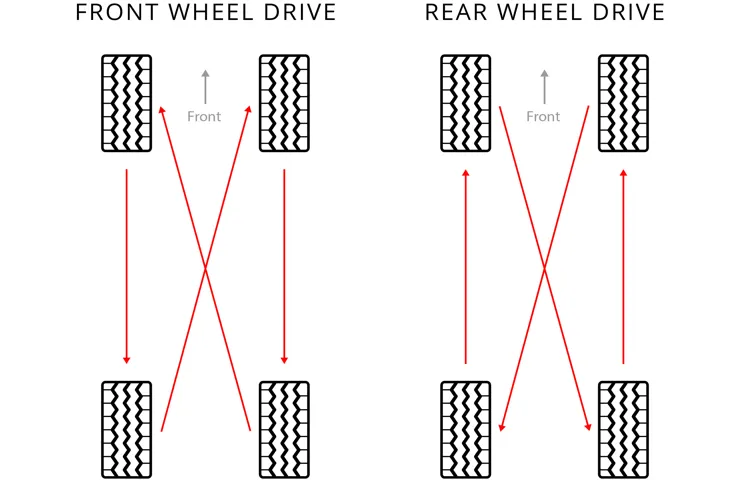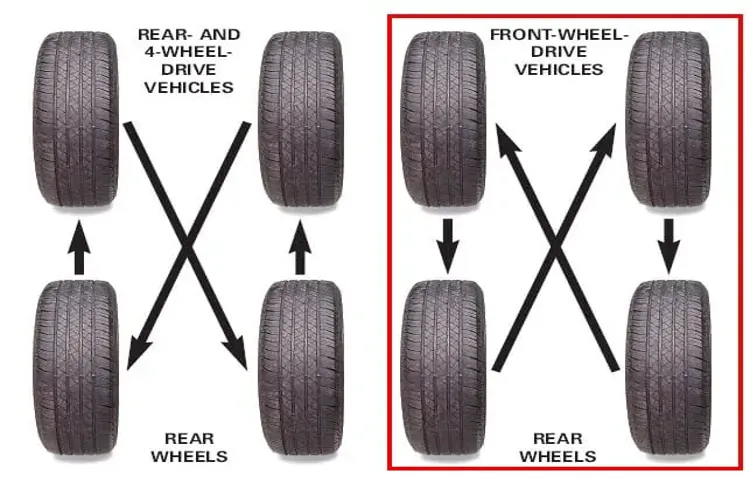Have you ever taken your car to the mechanic for tire maintenance and been bombarded with jargon you don’t understand? It’s easy to feel overwhelmed when you’re unfamiliar with the lingo but, in reality, tire maintenance isn’t too complicated. In fact, understanding the basics of tire maintenance is essential for ensuring your car drives safely, efficiently, and comfortably. From regularly checking tire pressure to identifying the signs of wear and tear, this guide will take you through everything you need to know to keep your tires in tip-top condition.
So, grab a cup of coffee and let’s dive into the world of tire maintenance!
Table of Contents
Tire Rotation vs Alignment
When it comes to maintaining the health of your tires, it’s important to know the difference between tire rotation and alignment. Tire rotation involves moving the tires to different positions on your vehicle, usually from front to back or diagonally, in order to promote even wear and extend the tire’s lifespan. On the other hand, tire alignment involves adjusting the angles of the wheels in order to ensure that they are all pointing in the right direction and are parallel to each other.
This ensures optimal handling, tire wear, and overall vehicle performance. While both services are important for keeping your tires in great condition, they serve different purposes and should be done at different intervals. Generally, tire rotation should be performed every 5,000 to 7,500 miles, while tire alignment should be done whenever you notice signs of uneven wear or handling issues while driving.
By regularly rotating and aligning your tires, you can help prevent blowouts, prolong the life of your tires, and enjoy a smoother, safer ride on the road.
Definition and Benefits
Tire rotation and alignment are two essential maintenance tasks for your vehicle. The tire rotation involves moving your tires from one wheel position to another, while the alignment involves adjusting the angles of your vehicle’s wheels. Tire rotation helps extend the life of your tires by evenly distributing wear and tear across all four tires.
On the other hand, wheel alignment ensures that your tires are pointing in the right direction, improving handling and preventing uneven wear. Doing both regularly can save you money in the long run by prolonging the lifespan of your tires and preventing expensive repairs. It’s like giving your car a tune-up and keeping it running smoothly to avoid breakdowns and costly repairs down the road.
So, don’t wait until there’s an issue with your tires or steering to get them checked- stay proactive and maintain your vehicle’s health!

Importance of Regular Maintenance
Regular maintenance is crucial to ensure that your car runs smoothly and stays safe on the road. Two critical components of maintenance are tire rotation and alignment. While both are necessary, they serve different purposes.
Tire rotation involves moving the tires from one position to another to ensure even wear and tear. This is essential because uneven wear can cause your tires to become imbalanced, leading to reduced traction and increased risk of accidents. On the other hand, alignment refers to the positioning of your wheels relative to each other and the road.
Proper alignment can reduce tire wear, improve fuel efficiency, and enhance handling and stability. So, it’s essential to have both tire rotation and alignment performed regularly. By doing so, you can rest assured that your car will be safe and reliable on the road.
So, don’t skip out on regular maintenance – it could save you a lot of trouble and money down the line!
Tire Rotation
When it comes to car maintenance, two terms that get thrown around a lot are tire rotation and alignment. While they both deal with the tires, they serve very different purposes. Tire rotation refers to moving the tires from one position to another, either diagonally or from front to back.
This helps to ensure that each tire wears evenly and extends their overall lifespan. In contrast, tire alignment involves adjusting the angles of the tires to ensure they are aligned with each other and the road properly. This helps improve handling, reduce tire wear, and overall ensures the vehicle drives straight.
So, remember, tire rotation is about even wear and tear, while tire alignment is about aligning the tires properly for optimal performance.
Process and Frequency
Tire Rotation is a crucial maintenance task that car owners should undertake. It involves switching the positions of the tires on a vehicle to ensure uniform wear and increase their lifespan. Typically, tire rotation should be done every 5,000 to 7,500 miles, although manufacturers may recommend different intervals based on the vehicle’s make and model.
It’s essential to follow these guidelines and have a professional mechanic inspect your tires regularly to avoid irregular wear patterns or bald spots. A good analogy to understand this process is like rotating the tires on a bike to maintain even wear, ensuring a smooth ride. Overall, regular tire rotation is essential to ensure the safe and efficient operation of your vehicle, reduce the likelihood of a tire blowout, and save you the cost of having to replace tires prematurely.
Cost and Time
Tire Rotation Getting your car’s tires rotated regularly is an essential maintenance task that can save you both time and money in the long run. By rotating your tires, you ensure that they wear evenly and last longer, preventing the need for costly replacements. The cost of tire rotation varies depending on the make and model of your car, but it typically ranges from $20 to $80.
If you’re on a budget, some automotive stores offer free tire rotation services when you purchase new tires from them, so it’s worth exploring those options. As for time, tire rotation can usually be done in under an hour, so it’s a relatively quick process. It’s recommended that you have your tires rotated every 6,000 to 8,000 miles.
However, this can also depend on your driving habits and the terrain you traverse. If you’re unsure of when to get your tires rotated, it’s always best to consult your owner’s manual or take your car to a mechanic. By taking care of your tires through regular rotation, you’ll not only save money on replacements but also improve your car’s performance and fuel efficiency.
It’s a small investment that can pay off big time in the long run. So if you haven’t gotten your tires rotated in a while, or are due for a check-up, don’t hesitate to schedule an appointment with your mechanic or local automotive store. Your car (and wallet) will thank you!
Benefits and Risks
Tire rotation is an important part of maintaining your vehicle’s performance and extending the life of your tires. By regularly rotating your tires, you ensure that the wear is evenly distributed, which can prevent uneven tread wear and improve traction on the road. If your front tires wear out faster than the rear ones, rotating the tires can also help improve your car’s handling and stability.
However, there are some risks involved with tire rotation as well. For example, if one tire is significantly more worn than the others, rotating it with newer tires can reduce overall performance and potentially compromise safety. Additionally, if your vehicle has a different sized tire on the spare, rotating it with the other tires can cause problems.
In general, it’s best to consult with a professional mechanic who can advise you on the best tire rotation schedule and strategy for your specific make and model of vehicle. By doing so, you can enjoy the benefits of tire rotation while avoiding potential risks and making the most out of your investment in new tires.
Wheel Alignment
Have you ever wondered about the difference between tire rotation and wheel alignment? While both play important roles in maintaining the longevity of your tires and ensuring a smooth ride, they serve different purposes. Tire rotation involves moving the tires to different positions on the vehicle in a specific pattern to ensure even wear and tear. On the other hand, wheel alignment involves adjusting the angle and position of your car’s wheels to ensure they’re perpendicular to the ground and parallel to each other.
Proper alignment ensures optimal handling, steering, and tire performance. While tire rotation is typically recommended every 5,000 to 7,000 miles, wheel alignment may be needed less frequently and will depend on factors such as road conditions and driving habits. It’s always best to consult with a professional mechanic to determine when your car requires a tire rotation or wheel alignment.
Process and Frequency
When it comes to maintaining your vehicle’s performance, wheel alignment plays a crucial role. Wheel alignment is the process of adjusting the wheels’ angles to ensure that they are parallel to each other and perpendicular to the ground. This process is essential as it ensures that your vehicle’s steering is precise and that your tires wear evenly.
Typically, experts recommend that you get your wheel alignment checked annually or at least every 10,000 miles, but this may vary depending on your driving habits and the terrain you typically drive on. Neglecting to get your wheel alignment checked and adjusted could result in uneven wear and tear on your tires, leading to a decrease in fuel efficiency and decreased handling. In short, getting your wheel alignment checked regularly is essential to keep your vehicle running smoothly and maintaining your safety on the road.
Cost and Time
When it comes to maintaining your vehicle, one important aspect is ensuring proper wheel alignment. Not only does it improve driving safety, but it can also save you money in the long run. A misaligned wheel can cause uneven tire wear and decrease fuel efficiency.
The cost of a wheel alignment may vary depending on the make and model of your car, but it typically ranges from $75 to $200. While this may seem like a high price tag, it’s important to consider the potential cost of not getting a wheel alignment, such as premature tire replacement. In terms of time, a wheel alignment usually takes about an hour to complete.
It’s a small investment that can have a significant impact on the overall health and longevity of your vehicle. So, next time you’re due for a maintenance check, don’t overlook the importance of getting your wheels aligned. Your wallet and your car will thank you.
Benefits and Risks
When it comes to maintaining your vehicle, wheel alignment is an essential aspect that can offer a lot of benefits. Proper wheel alignment ensures that your car drives straight and handles optimally, which improves safety and fuel efficiency. Misaligned wheels can cause uneven wear on your tires, leading to expensive replacements sooner than necessary.
However, wheel alignment also comes with risks, especially if you don’t address issues promptly. Potholes, curb hits, and even regular wear and tear can cause misalignments, so it’s crucial to have your wheels regularly checked and adjusted by a professional. Ignoring this maintenance can lead to decreased performance and instability while driving, increasing the risk of accidents.
Ultimately, proper wheel alignment can prolong your vehicle’s lifespan and save you money in the long run, but it’s essential to address any issues promptly to ensure your safety and overall driving experience.
Conclusion
In conclusion, tire rotation is like switching seats at a dinner party, it helps to even out wear and tear on your tires. Alignment, on the other hand, is like a chiropractic adjustment for your car, making sure everything is aligned and balanced for optimal performance. So, remember to rotate your tires regularly and get your alignment checked to keep your car running like a well-oiled machine!”
FAQs
1. What is tire rotation? A: Tire rotation refers to the practice of moving the tires of a vehicle from one position to another in a systematic fashion. 2. What is wheel alignment? A: Wheel alignment is the adjustment of a vehicle’s suspension – the system that connects the vehicle to its wheels – to ensure that the wheels are running parallel to each other and perpendicular to the road. 3. What is the purpose of tire rotation? A: The purpose of tire rotation is to promote even tire wear by ensuring that all four tires wear down at a similar rate. 4. What are the benefits of tire rotation? A: The benefits of tire rotation include extending the life of your tires, improving handling and traction, and ensuring that your vehicle tracks straight. 5. How often should you rotate your tires? A: Most experts recommend rotating your tires every 5,000 to 8,000 miles, depending on the make and model of your vehicle. 6. How much does tire rotation cost? A: The cost of tire rotation typically ranges from $20 to $50, depending on the type of vehicle and the location of the service. 7. How often do you need a wheel alignment? A: You should have your wheel alignment checked at least once a year, or if you notice that your vehicle is pulling to one side or the other while driving.



